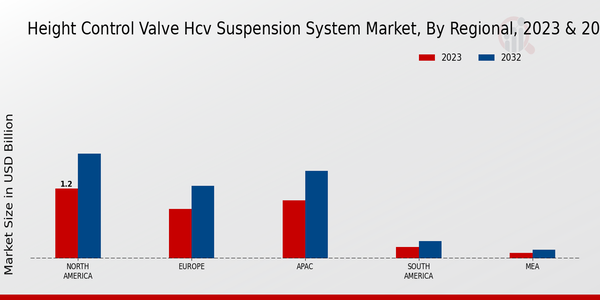Market Growth Projections
The Global Height Control Valve HCV Suspension System Market Industry is characterized by robust growth projections, with expectations of reaching 3.66 USD Billion in 2024 and 5.97 USD Billion by 2035. The anticipated CAGR of 4.55% from 2025 to 2035 suggests a steady increase in demand for height control valves, driven by advancements in automotive technology and changing consumer preferences. This growth trajectory indicates a positive outlook for manufacturers and stakeholders within the industry, as they adapt to evolving market dynamics and invest in innovative solutions to meet the needs of a diverse customer base.
Rising Demand for Commercial Vehicles
The Global Height Control Valve HCV Suspension System Market Industry is significantly influenced by the rising demand for commercial vehicles, particularly in logistics and transportation sectors. As businesses seek to enhance operational efficiency and reduce costs, the integration of height control valves in commercial vehicles becomes increasingly relevant. These systems contribute to improved load management and stability, which are critical for heavy-duty applications. The market is poised for growth, with projections indicating a rise to 5.97 USD Billion by 2035. This trend reflects the broader shift towards optimizing vehicle performance in commercial applications, highlighting the importance of height control technologies.
Increasing Adoption of Electric Vehicles
The Global Height Control Valve HCV Suspension System Market Industry is witnessing a notable shift with the increasing adoption of electric vehicles (EVs). As the automotive landscape transitions towards electrification, manufacturers are seeking to enhance the performance and efficiency of EVs through advanced suspension systems. Height control valves are integral to optimizing weight distribution and improving ride quality in electric vehicles. This trend is expected to gain momentum as more consumers opt for EVs, leading to a projected market value of 3.66 USD Billion in 2024. The growing emphasis on sustainability and performance in the EV segment is likely to drive further investments in height control technologies.
Regulatory Support for Emission Standards
The Global Height Control Valve HCV Suspension System Market Industry benefits from stringent regulatory frameworks aimed at reducing vehicle emissions. Governments worldwide are implementing policies that encourage the adoption of technologies that enhance fuel efficiency and lower emissions. Height control valves contribute to this goal by optimizing vehicle dynamics and improving aerodynamics. As a result, manufacturers are increasingly incorporating these systems into their vehicles to comply with evolving regulations. This regulatory push is expected to drive market growth, as evidenced by the projected increase to 5.97 USD Billion by 2035, indicating a sustained commitment to environmentally friendly automotive solutions.
Growing Demand for Advanced Suspension Systems
The Global Height Control Valve HCV Suspension System Market Industry experiences a surge in demand for advanced suspension systems, driven by the automotive sector's focus on enhancing vehicle performance and comfort. As consumers increasingly prioritize ride quality and safety, manufacturers are integrating height control valves into their designs. This trend is particularly evident in luxury and commercial vehicles, where the need for adaptive suspension systems is paramount. The market is projected to reach 3.66 USD Billion in 2024, reflecting a robust growth trajectory as automakers invest in innovative technologies to meet consumer expectations.
Technological Advancements in Suspension Systems
Technological advancements play a pivotal role in shaping the Global Height Control Valve HCV Suspension System Market Industry. Innovations in materials and design have led to the development of more efficient and reliable height control valves, enhancing overall vehicle performance. For instance, the integration of electronic control systems allows for real-time adjustments based on driving conditions, significantly improving ride comfort and handling. As these technologies continue to evolve, they are likely to attract investments from automotive manufacturers, further propelling market growth. The anticipated CAGR of 4.55% from 2025 to 2035 underscores the potential for ongoing innovation in this sector.




















Leave a Comment